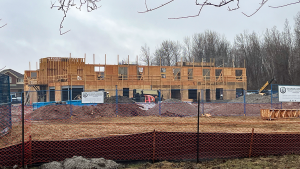The ICI construction sector’s recent focus on recruiting skilled workers to replace retiring boomers appears to be paying dividends, according to new analysis released by BuildForce Canada.
BuildForce’s annual national labour-force forecast, released March 26 and titled 2021–2030 Construction and Maintenance Looking Forward national report, projects that non-residential employment will increase by more than 39,800 workers between 2021 and 2025, and another 5,000 to 2030. The sector is expected to end the decade up 44,800 workers, plus eight per cent, compared to 2020.
As part of the equation, employers need to replace almost 259,100 workers, or 22 per cent of the current labour force, expected to retire during that period.
“Ontario’s non-residential sector has been seeing an increase in registrations and that was borne out by the latest data,” said BuildForce executive director Bill Ferreira. “The industry is doing a very good job of remaining focused on bringing new entrants into the industry and we anticipate that they will be able to exceed the number of retirements on the non-residential side of the industry over the course of a decade.”
The news isn’t quite as good for British Columbia, with its current hot market and forecasted strong growth. The province’s non-residential sector will be attracting more recruits than retirees will be leaving only for the near term, Ferreira said.
“That only holds for the next two years, and then retirement levels start to exceed the number of new entrants coming in.”
The report indicates retirements will remain an important factor in whether the construction sector manages to fulfill demand for workers for the rest of this decade.
“The last of the baby boomers will be eligible for retirement by 2030,” said Ferreira. “The overall trend is that retirements are increasing in the industry and the pool of younger workers available to enter the industry is in decline, and the competition from other industries, because all industries are facing very similar demographic challenges for those younger workers predisposed to working in the trades, is going to be incredibly intense.”
Overall, including residential, construction employment is expected to rise by 64,900 workers, up six per cent, between 2020 and 2030. The outlook shows slower growth later in the decade.
Residential employment is projected to rise by 20,100 workers (plus four per cent) over the coming decade. New-home construction is expected to peak in 2024 and then slow, the report indicates, while renovation and maintenance construction demands will rise during the decade.
That too is a function of the aging boomer demographic, Ferreira said.
“The overall trend tends to be as the population ages, the demand for new housing tends to diminish and the demand for renovation and maintenance tends to increase,” he said. “Most people tend to want to stay in their homes, particularly as they age. Many are looking to modify their homes so that they can age in place. And that trend is one that we’re picking up on.”
Other factors in boosting renovations are the work-from-home trend and increasing government support for retrofits.
The percentage of the labour force engaged in renovations and maintenance is expected to increase significantly, by 10 per cent and four per cent respectively, in the next 10 years.
“In fact, by the end of the decade, we anticipate that there will be more individuals employed in renovation and maintenance than there will be employed in new housing,” remarked Ferreira.
Other national construction workforce trends identified in the report include:
∙ Construction requirements across Canada are expected to rebound in 2021 as the sector recovers from the COVID-19 pandemic and rise through the coming decade, although at slower levels than in the past 10 years.
∙ Regionally, Newfoundland and Labrador will be the hardest hit among all jurisdictions in the next five years with overall construction employment expected to drop by 14.9 per cent in that period due to delays or cancellations of oil and gas projects caused by to instability in that market. Nova Scotia and Ontario, with spikes of 8.4 per cent and 8.3 per cent, will see the most growth between 2021 and 2025. British Columbia at 6.8-per-cent growth will be above the overall national growth projection of 6.4 per cent.
∙ In 2020, there were 190,000 women employed in Canada’s construction industry, with 27 per cent working onsite on construction projects. Of the nearly 1.1-million tradespeople employed in the industry, women made up five per cent.











Recent Comments
comments for this post are closed